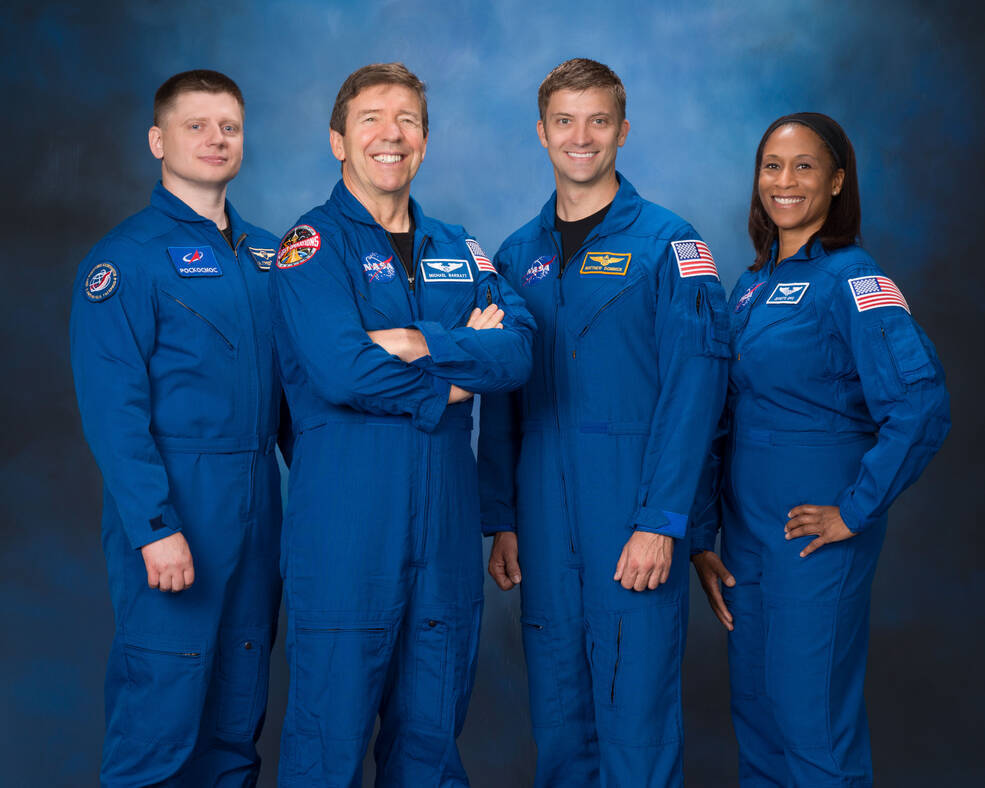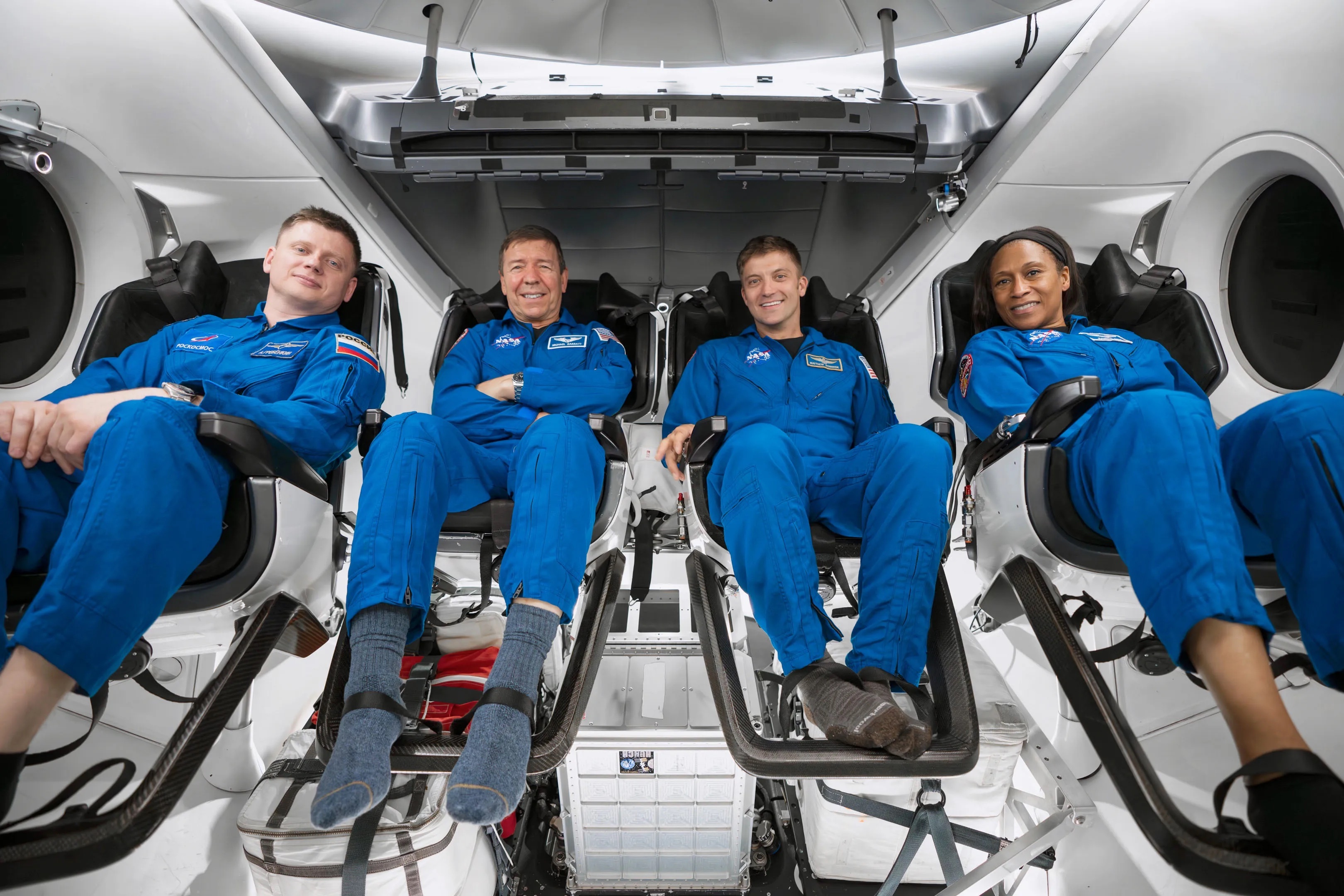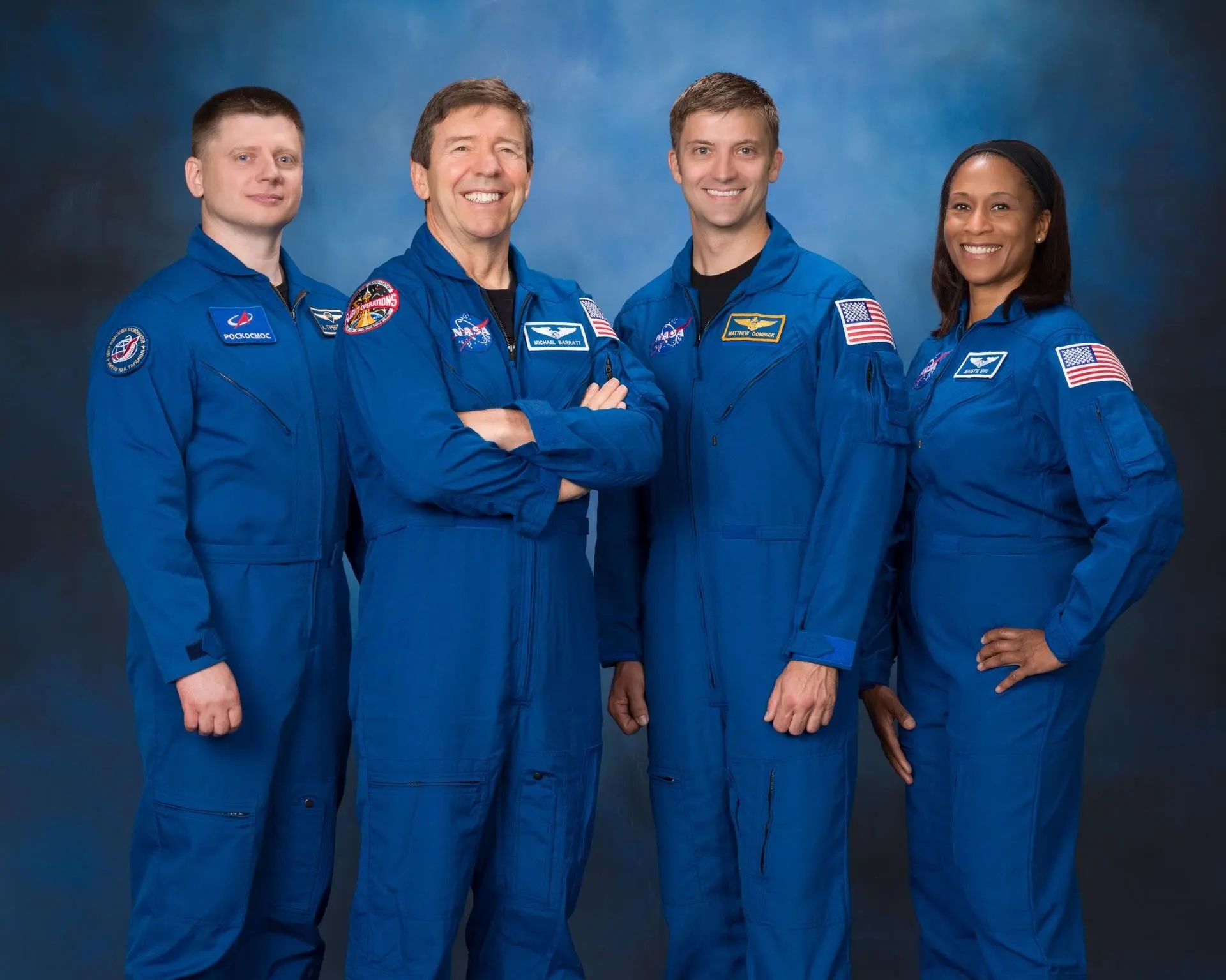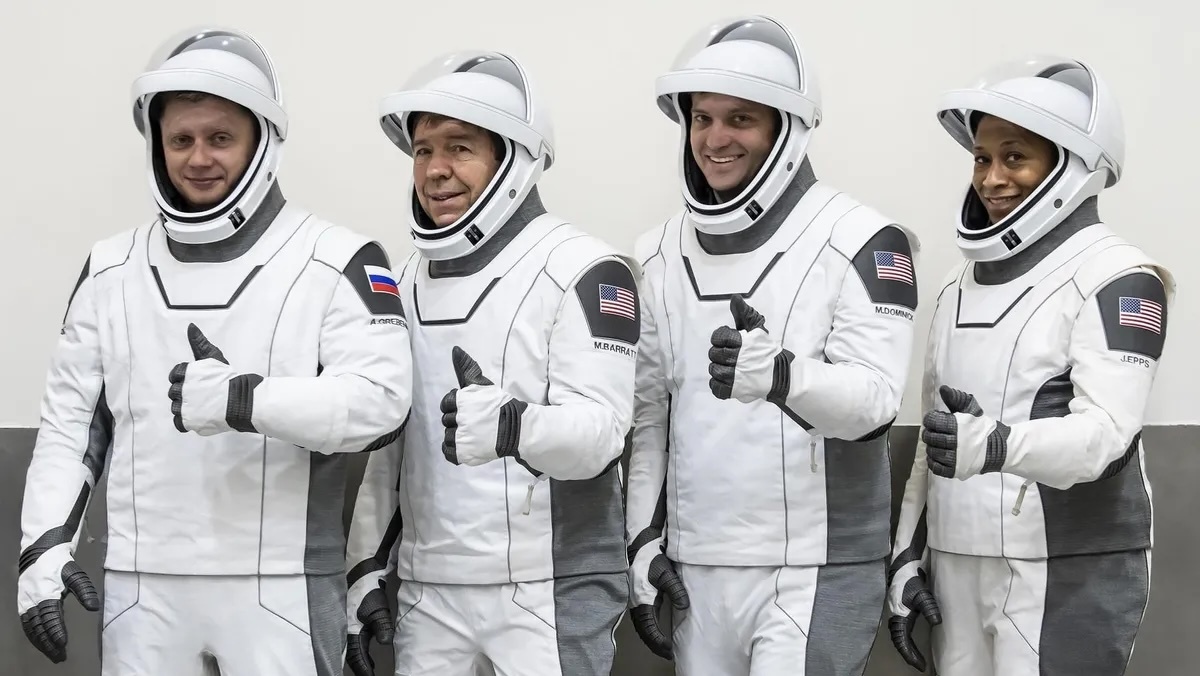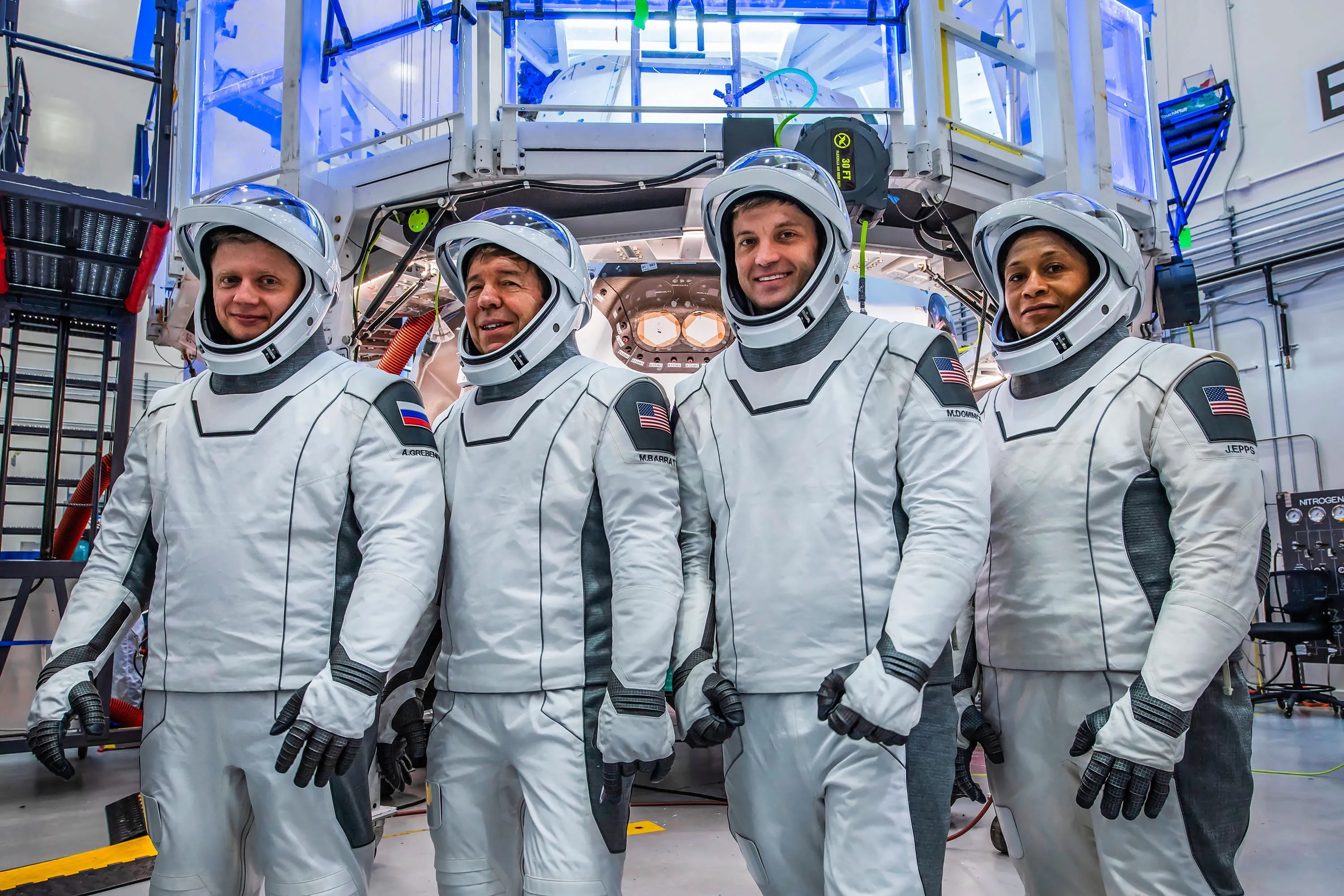The next International Space Station crew will lift off no earlier than late February after a moon mission clears the same launch pad, NASA officials announced today (Jan. 25).
"In terms of a launch date, we are looking at a late February timeline," Steve Stich, the manager of the commercial crew program at NASA's Johnson Space Center in Houston, said at a briefing Thursday livestreamed on NASA Television.
As its name suggests, Crew-8 is the eighth operational astronaut mission that SpaceX will fly to the ISS for NASA. The timing of the astronaut launch will very much depend on IM-1's status, Stich emphasized.
If IM-1 goes on time, Crew-8 would fly perhaps around Feb. 29 or March 1 from the Pad 39A, which SpaceX leases at KSC. But if IM-1 misses its narrow monthly window to reach the moon when lighting conditions are favorable for a landing, Crew-8 would stay groundbound until at least March 22 (assuming IM-1 departs in March).
While three of the Crew-8 astronauts are on their first mission, this is Barratt's third trip following flights in 2009 (ISS Expeditions 19-20) and 2011 (the space shuttle's STS-133).
Crew-8 will serve through the transition between Expeditions 70 and 71. Stich said the crew will return to Earth no earlier than August 2024; based on past space station rotations, Crew-8 will head home after SpaceX's four-astronaut Crew-9 flight arrives at the ISS for Expeditions 71/72.
Epps was immediately eligible for other space missions and was initially assigned the debut Starliner-1 crewed mission using Boeing's new spacecraft. But Epps was reassigned again to Crew-8 following lengthy delays in launching Starliner, which will be the second commercial crew vehicle to fly missions for NASA, after Crew Dragon.
Crew-8's astronauts may welcome the first Starliner mission with astronauts, called Crewed Flight Test (CFT), to the orbital lab in mid-April or so. CFT will bring veteran NASA astronauts Barry "Butch" Wilmore and Sunita Williams to the ISS for a short shakedown cruise.
An all-private crew on board the ISS right now, however, should be back at home by the time Crew-8 launches. That private crew, Axiom Space's Ax-3, launched Jan. 18 with SpaceX for a forecasted two-week mission at the ISS. It should touch down again on Earth around the second week of February.
(Left to right) Roscosmos Cosmonaut Alexander Grebenkin and NASA Astronauts Michael Barratt, Matthew Dominick, and Jeanette Epps pose for a photo during their Crew Equipment Interface Test at NASA’s Kennedy Space Center in Florida. The goal of the training is to rehearse launch day activities and get a close look at the spacecraft that will take them to the International Space Station.
NASA will provide coverage of the upcoming prelaunch and launch activities for the agency’s SpaceX Crew-8 mission with astronauts to the International Space Station.
The launch is targeted for 12:04 a.m. EST, Friday, March 1, from Launch Complex 39A at NASA’s Kennedy Space Center in Florida. The targeted docking time is about 7 a.m. on Saturday, March 2.
Crew arrival will be available on Kennedy’s streaming channels including YouTube and X. Coverage of launch, the postlaunch news conference, and docking will be available on NASA+, NASA Television, the NASA app, YouTube, and the agency’s website. NASA also will host an audio-only post-Flight Readiness Review news teleconference. Learn how to stream NASA TVthrough a variety of platforms including social media.
The Crew-8 launch will carry NASA astronauts Matthew Dominick, Michael Barratt, and Jeanette Epps, as well as Roscosmos cosmonaut Alexander Grebenkin.
As part of the agency’s Commercial Crew Program, the mission marks the eighth crew rotation mission and the ninth human spaceflight mission for NASA to the space station supported by a SpaceX Dragon spacecraft since 2020. Endeavour is the name of this Dragon spacecraft.
The deadline for media accreditation for in-person coverage of this launch has passed. The agency’s media credentialing policy is available online. For questions about media accreditation, please email: ksc-media-accreditat@mail.nasa.gov.
NASA’s mission coverage is as follows (all times Eastern and subject to change based on real-time operations):
Sunday, Feb. 25:
2 p.m. – Crew arrival media event at Kennedy streaming on the center’s social accounts with the following participants:
- Jennifer Kunz, associate director, technical, NASA Kennedy
- Dana Hutcherson, deputy program manager, Commercial Crew Program, NASA Kennedy
- NASA astronaut Matthew Dominick
- NASA astronaut Michael Barratt
- NASA astronaut Jeanette Epps
- Roscosmos cosmonaut Alexander Grebenkin
The event is limited to in-person media only. Follow Commercial Crew and Kennedy Space Center for the latest arrival updates.
6 p.m. (approximately) – Flight Readiness Review media teleconference (no earlier than one hour after completion of the Flight Readiness Review) with the following participants:
- Ken Bowersox, associate administrator, Space Operations Mission Directorate, NASA Headquarters
- Steve Stich, manager, Commercial Crew Program, NASA Kennedy
- Joel Montalbano, manager, International Space Station Program, NASA Johnson
- William Gerstenmaier, vice president, Build and Flight Reliability, SpaceX
- Eric van der Wal, Houston office team leader, ESA (European Space Agency)
- Takayoshi Nishikawa, director, JAXA (Japan Aerospace Exploration Agency) Houston Office
Media may ask questions via phone only. For the dial-in number and passcode, please contact the Kennedy newsroom no later than 3 p.m. Friday, Feb. 23, at: ksc-newsroom@mail.nasa.gov.
Wednesday, Feb. 28:
9:15 a.m. – NASA Social panel live stream event at Kennedy with the following participants:
- NASA Associate Administrator Jim Free
- Carla Koch, mission manager, Commercial Crew Program, NASA Kennedy
- Jennifer Buchli, chief scientist, International Space Station Program, NASA Johnson
- Kristin Fabre, deputy chief scientist, Human Research Program, NASA Johnson
Members of the public may ask questions online by posting questions to the YouTube, Facebook, and X livestreams using #AskNASA.
10:30 a.m. – NASA Administrator briefing from Kennedy with the following participants:
- NASA Administrator Bill Nelson
- NASA Associate Administrator Jim Free
- Joel Montalbano, manager, International Space Station Program
- Steve Stich, manager, Commercial Crew Program
Media may ask questions in person and via phone. Limited auditorium space will be available for in-person participation. For the dial-in number and passcode, media should contact the Kennedy newsroom no later than 9:30 a.m. Wednesday, Feb. 28, at ksc-newsroom@mail.nasa.gov.
12:30 p.m. – One-on-one media interviews at Kennedy with various mission subject matter experts. Sign-up information will be emailed to media accredited to attend this launch in person.
Thursday, Feb. 29:
8 p.m. – NASA TV launch coverage begins
Friday, March 1:
12:04 a.m. – Launch
Following conclusion of launch and ascent coverage, NASA coverage will continue with audio only, with full coverage resuming at the start of the rendezvous and docking broadcast. The audio link and details will be available nearer to the mission.
NASA Television will resume continuous mission coverage prior to docking and continue through hatch open and the welcome ceremony. For NASA TV downlink information, schedules, and links to streaming video, visit:
https://www.nasa.gov/nasatv/
2 a.m. (approximately) – Postlaunch news conference on NASA TV
- Steve Stich, manager, Commercial Crew Program
- Joel Montalbano, manager, International Space Station Program
- Sarah Walker, director, Dragon Mission Management, SpaceX
Media may ask questions in person and via phone. Limited auditorium space will be available for in-person participation. For the dial-in number and passcode, please contact the Kennedy newsroom no later than 12 a.m. Friday, March 1, at ksc-newsroom@mail.nasa.gov.
Saturday, March 2:
5 a.m. – NASA TV arrival coverage begins (or about two hours prior to docking)
7 a.m. – Targeted docking to the forward-facing port of the station’s Harmony module
Hatch opening will be approximately one-hour-and-forty-five minutes after docking followed by welcome remarks aboard station. All times are estimates and could be adjusted based on operations after launch. Follow the space station blog for the most up-to-date operations information.
Audio Only Coverage
Audio only of the news conferences and launch coverage will be carried on the NASA “V” circuits, which may be accessed by dialing 321-867-1220, -1240 or -7135. On launch day, “mission audio,” countdown activities without NASA TV launch commentary, will be carried on 321-867-7135.
Launch audio also will be available on Launch Information Service and Amateur Television System’s VHF radio frequency 146.940 MHz and KSC Amateur Radio Club’s UHF radio frequency 444.925 MHz, FM mode, heard within Brevard County on the Space Coast.
Live Video Coverage Prior to Launch
NASA will provide a live video feed of Launch Complex 39A approximately 48 hours prior to the planned liftoff of the Crew-8 mission. Pending unlikely technical issues, the feed will be uninterrupted until the prelaunch broadcast begins on NASA TV, approximately four hours prior to launch. Once the feed is live, find it here:
http://youtube.com/kscnewsroom.
NASA Website Launch Coverage
Launch day coverage of NASA’s SpaceX Crew-8 mission will be available on the agency’s website. Coverage will include live streaming and blog updates beginning no earlier than 8 p.m. Feb. 29, as the countdown milestones occur. On-demand streaming video and photos of the launch will be available shortly after liftoff.
For questions about countdown coverage, contact the Kennedy newsroom at 321-867-2468. Follow countdown coverage on the commercial crew or Crew-8 blog.
Attend the Launch Virtually
Members of the public can register to attend this launch virtually. NASA’s virtual guest program for this mission also includes curated launch resources, notifications about related opportunities or changes, and a stamp for the NASA virtual guest passport following a successful launch.
Watch and Engage on Social Media
Let people know you’re following the mission on X, Facebook, and Instagram by using the hashtags #Crew8 and #NASASocial. You can also stay connected by following and tagging these accounts:
X: @NASA, @NASAKennedy, @NASASocial, @Space_Station, @ISS_Research, @ISS National Lab, @SpaceX, @Commercial_Crew
Facebook: NASA, NASAKennedy, ISS, ISS National Lab
Instagram: @NASA, @NASAKennedy, @ISS, @ISSNationalLab, @SpaceX
Coverage en Espanol
Did you know NASA has a Spanish section called NASA en Espanol? Make sure to check out NASA en Espanol on X, Instagram, Facebook, and YouTube for more coverage on Crew-8.
Para obtener información sobre cobertura en español en el Centro Espacial Kennedy o si desea solicitar entrevistas en español, comuníquese con Antonia Jaramillo: 321-501-8425;antonia.jaramillobotero@nasa.gov; o Messod Bendayan: 256-930-1371;messod.c.bendayan@nasa.gov.
NASA’s Commercial Crew Program has delivered on its goal of safe, reliable, and cost-effective transportation to and from the International Space Station from the United States through a partnership with American private industry. This partnership is changing the arc of human spaceflight history by opening access to low Earth orbit and the International Space Station to more people, more science, and more commercial opportunities. The space station remains the springboard to NASA’s next great leap in space exploration, including future missions to the Moon and, eventually, to Mars.
Quelle: NASA
----
Update: 27.02.2024
.
Astronauts, cosmonaut arrive at Kennedy Space Center ahead of NASA, SpaceX Crew-8 launch
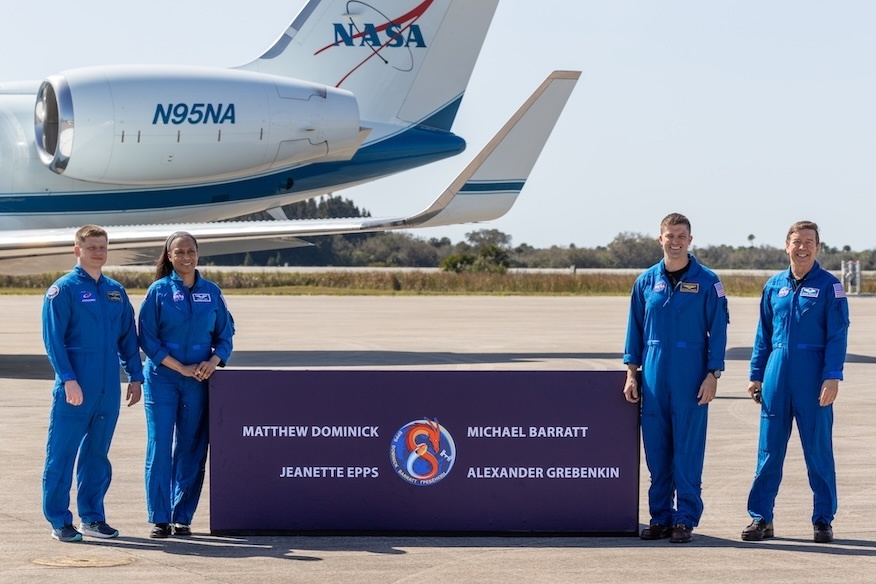
The four members of the SpaceX Crew-8 mission pose in front of the NASA Gulfstream plane at Space Florida’s Launch and Landing Facility. (Left to right) Roscosmos Cosmonaut Alexander Grebenkin and NASA Astronauts Jeanette Epps, Matthew Dominick and Michael Barratt. Image: Adam Bernstein/Spaceflight Now
Set against a bright, blue Florida skyline, the three astronauts and one cosmonaut who make up the SpaceX Crew-8 mission touched down at NASA’s Kennedy Space Center Sunday afternoon.
The crew’s Gulfstream cruised in for a landing at the Space Florida Launch and Landing Facility at about 1:45 p.m. (1845 UTC). They were greeted on the tarmac by, Jennifer Kunz, a KSC Associate Director, and Dana Hutcherson, Deputy Director Commercial Crew.
“Coming out here to the Cape, every time, I’m a kid in a candy store,” said Matthew Dominick, a NASA astronaut and the commander of the Crew-8 mission.
While the upcoming mission will be the first spaceflight for Dominick, he worked for NASA for seven years leading up this launch.
“It’s an incredible time to be involved in spaceflight. Who would’ve though five or six years ago that this would be the fifth flight of Endeavour that we get to go on? Who would’ve though five or six years ago that the competition for launch or the constraint to launch would be a launch pad?” Dominick said, referring to the recent launch of the IM-1 robotic mission to the Moon. “We delayed our launch a few days because there’s stiff competition to get out there to 39A. It’s not a rocket constraint, it’s a pad constraint.”
He’s leading a trio that include two additional NASA astronauts, Michael Barratt and Jeanette Epps, and Roscosmos cosmonaut, Alexander Grebenkin. They will launch to the orbiting outpost no earlier than Friday, March 1 at 12:04 a.m. EST (0504 UTC).
Barratt is returning to launch at KSC for the first time since his final flight as a member of STS-133 in 2011. He said it’s remarkable to be back now in the era of the Commercial Crew Program and be preparing to launch atop a SpaceX Falcon 9 rocket and inside a Crew Dragon spacecraft.
“The fact that this spaceport is so busy, so vibrant is just an amazing thing,” Barratt said. “It’s just an absolute pleasure to see Kennedy Space Center being the thriving spaceport that it is. We’re very honored to be a part of that. I cannot wait to get back to that magnificent station, I can’t wait to fly this new spaceship and I can’t wait to to fly with this crew.”
Like Dominick and Grebenkin, Epps will be making her first trip to space on this mission. She’s experienced pivots from flying on a Russian Soyuz to then Boeing Starliner and finally to her current assignment on Crew-8.
“It’s overwhelming to me how many people contributed to this. So, I just want to thank everyone who’s been involved,” Epps said. “I’m very grateful for this flight. I’ve trained for Soyuz, I’ve trained for Boeing, I’ve trained for a lot of vehicles, but I’m honored to fly with this crew on the Dragon Endeavour.”
Endeavor will be making its 5th flight into space on this mission, marking its position as the flight leader in the SpaceX spacecraft fleet. Five missions is the most that NASA has certified a Dragon to fly to date.
A new Dragon spacecraft is expected to enter the fleet sometime in 2024.
Quelle: Spaceflight Now
----
Update: 29.01.2024
.
NASA, SpaceX Target Saturday, March 2, for Crew-8 Launch
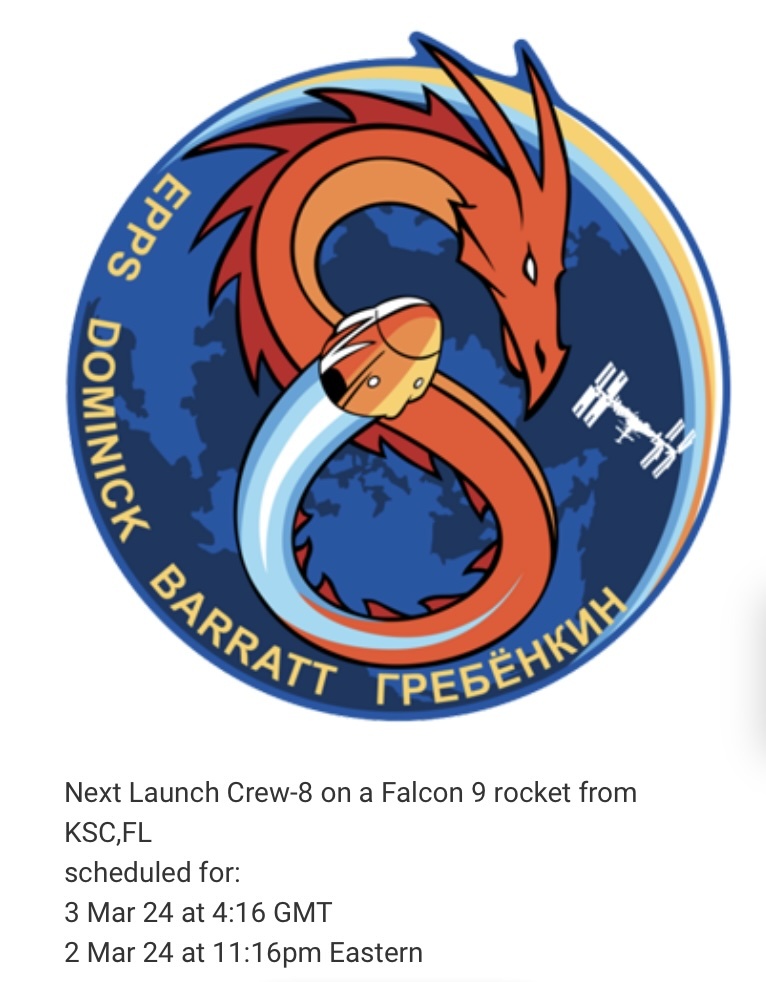
NASA and SpaceX now are targeting 11:16 p.m. EST Saturday, March 2, for the launch of the agency’s Crew-8 mission to the International Space Station. Joint teams selected the updated launch opportunity due to unfavorable weather conditions forecast for Friday, March 1, in offshore areas along the flight track of the Dragon spacecraft. High wind and waves along the eastern seaboard have been observed and are forecast to continue through Saturday morning. In the unlikely case of an abort during launch or the flight of Dragon, the wind and wave conditions must be within acceptable conditions for the safe recovery of the crew and spacecraft.
The live broadcast of the mission – including liftoff and postlaunch milestones – will air on NASA+, NASA Television, the NASA app, YouTube, and the agency’s website at 7:15 p.m. EST. Docking coverage will begin at 11:30 a.m. on Sunday, March 3, for a docking scheduled for approximately 2:10 p.m.
We’ll keep you updated on the key milestones throughout this mission. Details about the mission and NASA’s Commercial Crew Program can be found by following the Crew-8 blog, the commercial crew blog, X, and Facebook.
Quelle: NASA
----
Update: 3.03.2024
.
NASA's SpaceX Crew-8 launch tonight: What to know about the mission from Cape Canaveral
It's launch day for Crew-8 to lift off to the International Space Station — so long as the weather cooperates!
NASA and SpaceX are targeting 11:16 p.m. EST to launch a Falcon 9 rocket carrying the four Crew-8 members aboard the Dragon Endeavour capsule from pad 39A at Kennedy Space Center.
However, the Space Force's 45th Weather Squadron only pins the odds of "go for launch" conditions at 40%, citing threats of precipitation, cumulus clouds and a moderate-to-high risk of poor ascent corridor weather.
The Falcon 9 is projected to fly in a northeasterly trajectory. The rocket's first-stage booster will target landing at Cape Canaveral Space Force Station 7 minutes, 38 seconds after liftoff, generating sonic booms in Brevard County.
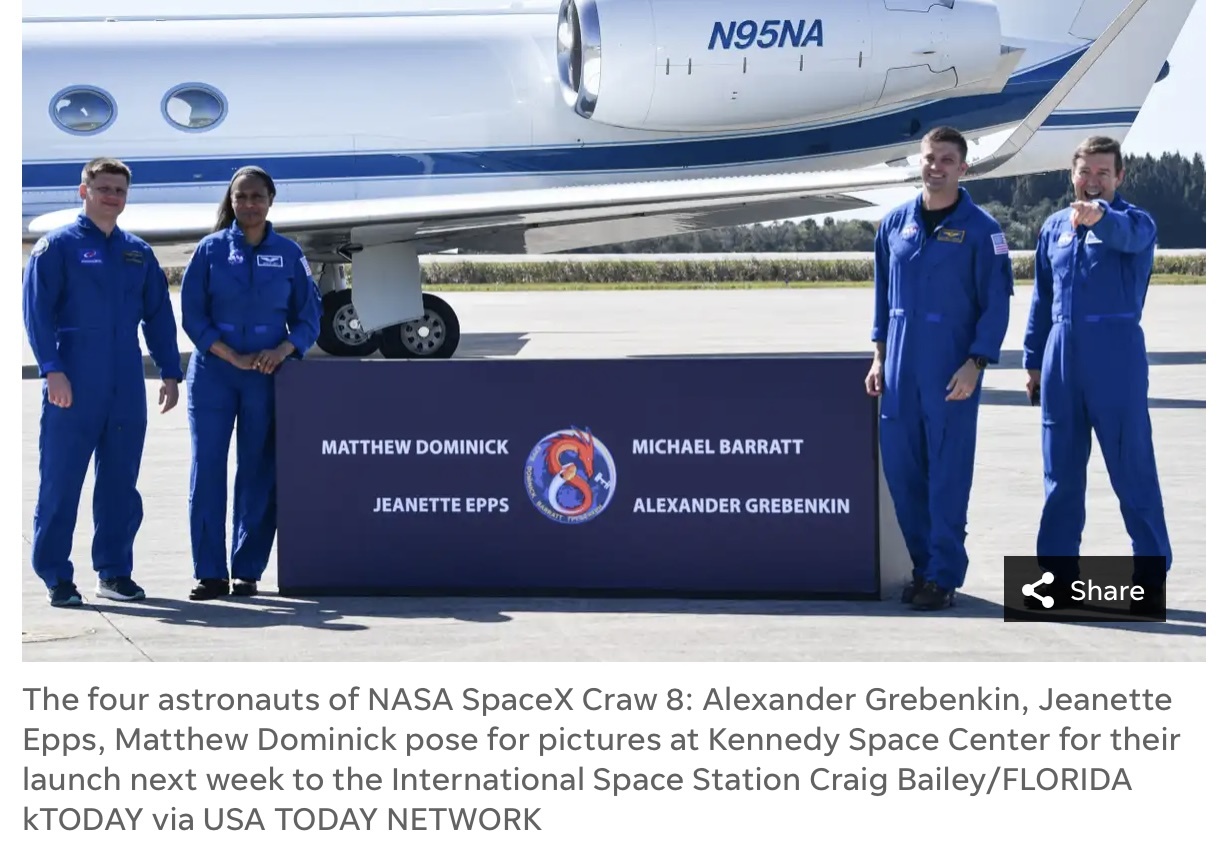
The Crew-8 astronauts addressed more than 30 photographers and reporters after flying aboard a NASA jet to the KSC Launch and Landing Facility.
Quelle: Florida Today
+++
Update: 3.03.2024 / 19:00 MEZ
.
Scrub! NASA's SpaceX Crew-8 stands down from launch attempt, will try again Sunday night
After standing down Saturday night, NASA's SpaceX Crew-8 launch from Kennedy Space Center has been rescheduled with a new target liftoff time of 10:53 p.m. EST Sunday.
The Space Force's 45th Weather Squadron had only pegged the odds of "go for launch" conditions on Saturday night at 40%, citing threats of precipitation, cumulus clouds and a moderate-to-high risk of poor ascent corridor weather.
Sure enough, crews called off the launch attempt more than three hours before liftoff — before the Crew-8 astronauts had the chance to board waiting Teslas to drive to pad 39A.
"Standing down from tonight's launch of Crew-8 due to elevated winds in Dragon's ascent corridor. Now targeting Sunday, March 3 for liftoff," SpaceX officials tweeted at 7:52 p.m.
As a result, SpaceX's uncrewed Starlink 6-41 mission — which had a Falcon 9 launch window scheduled to open Sunday evening — will also be postponed.
Crew-8's Falcon 9 rocket will carry the quartet aboard the Dragon Endeavour capsule into low-Earth orbit in a northeasterly trajectory. The rocket's first-stage booster will target landing at Cape Canaveral Space Force Station 7 minutes, 38 seconds after liftoff, generating sonic booms in Brevard County.
The 45th Weather Squadron forecast shows the chance of favorable launch conditions jump up to 75% on Sunday night.
"During the back-up launch window Sunday evening, most of the shower activity is expected to be displaced across the interior and western portions of the peninsula, but a few showers and mid-level clouds may persist locally," the squadron's forecast said.
"The main concerns for Sunday evening attempt will be Flight Through Precipitation and the Cumulus Cloud Rule," the forecast said.
Below are a few updates from FLORIDA TODAY's Space Team during the run-up to Saturday's scrub.
Scrub!
Update 7:56 p.m.: Officials have called off tonight's Crew-8 launch attempt.
"Standing down from tonight's launch of Crew-8 due to elevated winds in Dragon's ascent corridor. Now targeting Sunday, March 3 for liftoff," SpaceX officials announced in a tweet.
Tomorrow's backup launch target is 10:53 p.m.
NASA's weather go/no-go call coming later
Update 7:48 p.m.: In a tweet, NASA astronaut Raja Chari — who is co-hosting the NASA TV broadcast — said officials will make a weather go/no-go call one hour before the 11:16 p.m. liftoff time.
Chari commanded the Crew-3 mission to the ISS, which launched in November 2021. His international crew spent 177 days in orbit.
SpaceX earlier: 'All systems are looking good'
Update 7:16 p.m.: The Crew-8 astronauts are suiting up as we speak. SpaceX officials last tweeted a Crew-8 mission update at 11:41 a.m.
Quelle: Florida Today



